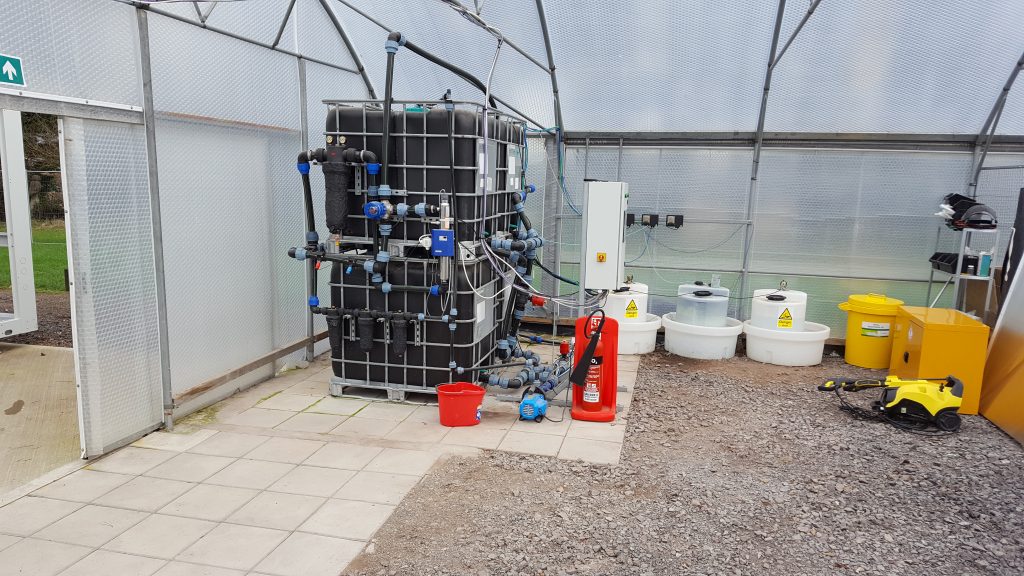A few miles West of Dundee is the Intelligent Growth Solutions’ (IGS) vertical farm, on the James Hutton Institute campus. On the outside, it looks like a square steel structure, ten-meters-high, in a muddy field. Inside, there are four ‘towers’, each of which potentially contain 50 growing trays (40 square meters each) which are stacked in their solid steel racks, a bit like giant tray stackers for dirty dishes in a fast food restaurant. These are filled with basil, dill, coriander and other low bright green leafy plants, arranged in neat rows, under small brightly coloured LED lights that are fitted to the underside of each tray lighting the plants in the tray below.

Complete control over inputs and outputs
Every input is specified precisely, monitored at all times and adjusted to develop best results. The inputs (temperature, light in the form of LEDs of six different frequencies including infrared, humidity/water, and nutrients) are fed in following ‘recipes’ that are developed following the latest pilot project. You can see the computer screens that monitor the inputs on site and hear the alarms that warn of particular developments. These controls can be adjusted remotely from an office somewhere, in theory anywhere in the world. Complete control and careful and constant automatic monitoring allow for experimentation to find the most ‘efficient’ recipes that maximise the desired outputs. Basil and similar small green crops can currently be harvested from these trays at a rate of up to 15 – 16 times annually.
Water use is minimal. It is harvested from the trays and fed back into the supply tanks whilst regulating exact humidity control. Each tower has its own tank and filters take out what is not wanted. No pesticides are needed as air locks ensure that people don’t bring in pests from outside, and remotely controlled simple robots can in future do all of the work inside the towers. It takes only one person to operate the daily tasks associated with running this growing system and most of these tasks take place outside the towers. They prepare the trays (cleaning, planting) and keep an eye on the inputs. Most of this work is also expected to be automated in future.

Clearly, this system comes with large start-up costs. The guide estimates that it costs approximately £2 million to build a structure of two towers. And there is a massive daily electricity bill. He mentions that it is helpful to have large customers like these to tap the grid of surplus electricity in remote places, and therefore these customers are given large discounts.
Potential benefits and limitations
Considering how inputs can be manipulated so precisely, this growing model offers all sorts of exciting possibilities for research and crop development that further the agendas of precision farming and plant research. Especially also bearing in mind that this system allows for running experiments on a timescale that is typically 15 times faster than growing these crops in traditional ways. (In central Scotland you might manage two rotations for some crops, only in good conditions.)
The tour guide tells us that IGS is trying to sell one or two of these towers to private farmers for in the remote corners of Scotland ‘to ensure a supply of fresh food all year round in remote communities’. However, when we discussed this in more detail, it turns out that there are a few ‘but’s.Their current growing recipes do not allow for growing cereals, because cereal plants are too high (but the key word is ‘currently’). Not potatoes nor other root crops either (currently), because everything grows in a thin layer of coir which does not hold much of a root structure. (Coir is a waste product of coconut husks. ‘Very sustainable’ according to the guide, but does that depend on where you start counting the footprint?) Pollination is also a tricky challenge in the growing towers, as they do not welcome insects (‘pests’ is the keyword here). (Pollination is currently done manually, but there are plans for automating this too.) For now and in the near future, that limits growing soft fruits in these towers as well.
So, we are left wondering what we can grow in these trays that the communities in remote corners of Scotland will actually eat. Clearly it is not a strategy for managing food security just yet.
In its current state, it lends itself best to plant research and perhaps to growing a large amount of green herbs, salads and perhaps microgreens, and similar. So it might solve logistics for high-end restaurants? However, these tend not to be found in remote places (where the huge electricity bill is subsidised). And besides, if we want to avoid having to transport these fragile crops to places all over the country from the remote corners of Scotland, the towers are probably best built next to a large supermarket distribution centre on the outskirts of London. But what about the electricity bill then? And in any case, would it not be more sensible to develop glasshouse technology instead so we could save on paying for light during daylight hours? Other than a system operator and people to do the packaging and transport the large amounts of fragile produce, we also established that this system does not create on-site high-quality rural jobs either. So we conclude that there is limited scope for rural regeneration, then.
The question has to be asked who benefits from this particular high-tech approach to farming, especially if public money is fed into developing it. Perhaps the fact that their largest investor is one of the big supermarkets gives us a clue. Or perhaps, to be fair, it could be useful in places where water is really scarce and this is the only way to grow anything at all, like in the Saudi (or Californian/Texan?) desert?